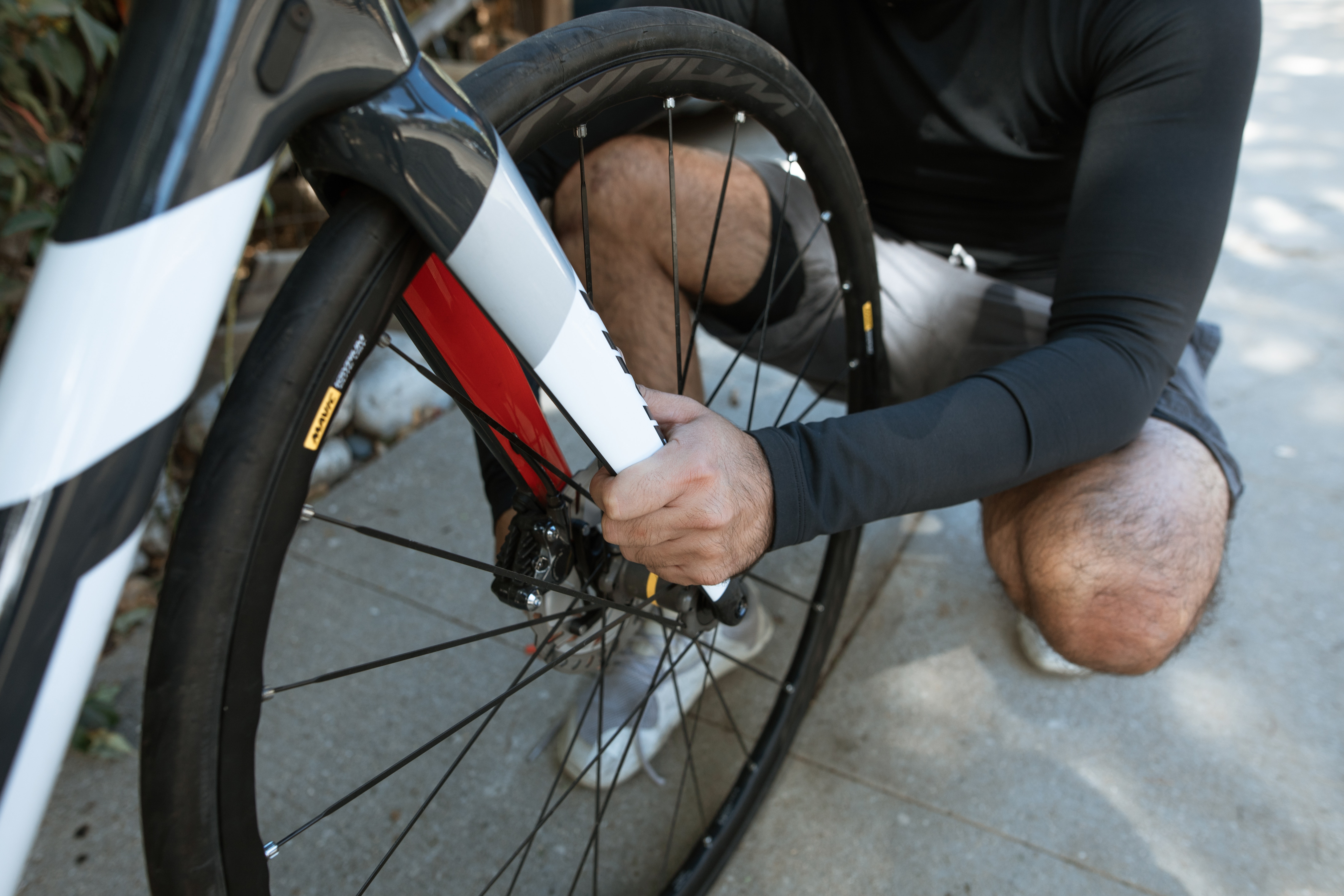From Karl von Drais 1817 “velocipede” to today’s electric bikes, bicycles have a long history. It’s a history that continues to move forward with new designs and technologies. Whether we look at the precursors to the modern bicycle or new variations on it we’re looking at a changing technology.
The change in designs over two centuries has mostly been in response to inherent problems in design. But, with the advent of the modern bicycle design changes began to specialise bikes to specific tasks. This trend has continued today alongside the introduction of new technologies to create a varied list of bike types.
I’m not sure how many people within the industry look as far back as the 1800’s for the history of bikes. To be fair there’s no real reason to, penny-farthings don’t have much bearing on modern design. It is interesting to look back though. So for anyone curious we thought we’d have a look back at the history of bike design.
The Father Of The Bicycle
The first significant invention to resemble modern bikes was probably Karl von Drais “velocipede”. There were earlier inventions but this was the first with the ability to turn by allowing the front wheel to pivot. These were not at all comfortable bikes. They had no suspension to speak of, being made nearly entirely of wood.
They did look remarkably similar to modern bikes though. Even more similar than some of the designs that came after. They varied in one very important aspect though. The velocipede had no pedals. Instead you would kick off the ground or run and hop on, more like you would operate a scooter today.
Maybe because of the novelty of the idea velocipedes became very popular in France and England. By the mid 1820’s they were rarely seen anymore though. Ultimately they were uncomfortable and difficult to ride. Jokes were made about a vehicle that could travel fourteen miles in fifteen days. In the end they were deemed a nuisance and banned in several cities. They were continued to be improved upon though eventually leading us to the modern bicycle.
Today we still have balance bikes. Usually these are just seen as a way for kids to learn to ride a bike, but they are available for adults too. They’re great for developing a sense of balance early on but you’re not going to find many people commuting on one.
The First Pedals
The introduction of pedals brought us a lot closer to our modern ideas of bikes. It would be over forty years before pedals were added to Drais design though. Several prototypes came to the fore in the 1860’s. Pierre Michaux was responsible for one that made it to the public. His design would come to be nicknamed “the bones shaker” due to it’s uncomfortable rides.
Weighing an average of 60lbs and made with solid wheels. I can imagine you would feel every bump on the road while riding one of these bikes. There was another problem though. The pedals were attached to the front axle. This meant that while pedalling the front wheel had a tendency to swing towards the foot applying forward momentum. Bone shakers were heavy, hard to control and incredibly uncomfortable, but they still had a way of propelling themselves.
Despite its problems bone shakers and enjoyed a brief popularity but it wasn’t long before a new design came along.
Penny Farthings
The penny farthing is probably the most iconic step in the development of bikes. Characterised by the enlarged front wheel it’s what most people think of when they hear old-timey bike. It’s also the design that essentially done away with the bone shakers that came before it.
The larger front wheel allowed for higher speeds and a smoother ride. In general this made for a much more comfortable experience although some practice was needed to mount properly. They became much more popular as a result.
Comfort is not the same as safety though. Because you sat high and over the front axle penny farthings could be quite dangerous. There was a very real risk that if the bike struck a rock or if you were to brake too hard you would be flung over the handlebars. This was a fairly common occurrence and sometimes fatal.
The popularity of the penny farthing was short-lived though. Once again the design would become obsolete fairly quickly with the development of new technologies. These technologies would bring us to what can be seen as the first of the modern bicycles.
Chain Drives and Tyres
These technologies made the penny farthing obsolete fairly quickly. With the combination of the two you could create a fast and smooth ride (comparatively) without the risk of sitting high on the penny farthing. Though the first safety bicycles didn’t catch on. They were more expensive and complex than penny farthings which decreased the interest.
The first commercially successful safety bicycle was produced in 1885 by John Kemp Stanley. The Rover. Though it was still more expensive it managed to catch on. By using a chain drive these bikes allowed for a much more efficient transfer of force to the wheels. Rather than turning the wheel directly the chain acted on them. This also meant that the pedals no longer had to be attached to the wheel, getting rid of the problem of veering wheels on the bone shakers.
Even if you could now go faster with smaller wheels they still proved to be less comfortable. At least until pneumatic tyres. These tyres provided a cushion for the bike making it much smoother to ride. This was the last innovation that was needed to create the modern bike. The design remained popular and it’s still the basic idea that we use today. Although material advancements and improvements to geometry have allowed a lot more variation.
Designed For Specificity
With the basic framework for bicycles in place changes in design started to take a new direction. Rather than replacing what came before bikes branched off into specialised designs. New technologies and ideas meant new types of bikes but the basic idea stay roughly the same.
Improvements in material technology mean that we can create lighter and more durable bikes. Smoother rides than the early safety bicycles could ever achieve. We can improve suspension and geometry to fine tune just how a bike feels and rides.
I won’t go too in depth into all the new technologies that make this possible. This post would just get too long. Instead let’s take a quick look at two different kinds of bikes.
Mountain Bikes And Road Bikes.
Mountain bikes are designed for heavy duty off road riding. Whether it’s a downhill or a trail bike they are built to be tough and stable. Road bikes on the other hand prioritise compactness and aerodynamics. For example a road bike tend to have a longer top tube which lets the rider adopt a more aerodynamic posture. This just isn’t necessary for a mountain bike.
There’s plenty of differences between the frames. Once again too many for the scope of this article. Cycling News has a great article that covers what’s here in more detail and a lot more. To keep it simple the frame of a mountain bike it built to keep the bike balanced downhill and aid in handling. It does this partly by keeping the handlebars closer to the rider and having a gentler angle on the head tube.
The frame of the road bike will have a steeper head tube since you don’t need to take the same kind of turns on a regular basis it doesn’t need the handling of a mountain bike. They also tend to be more compact and lighter since they don’t need to suffer the same punishment and need to be ridden for longer periods of time by many people. This also makes storing them a lot easier.
One of the key differences between the two bikes is suspension. Road bikes don’t need or have it. Mountain bikes are pretty unique in having suspension as a bike. They wouldn’t work too well without it though. They just take too much impact for pneumatic tyres and frame geometry to deal with comfortably. Suspension allowed for the creation of a new brand of bikes.
Electric Bikes
This is where we’re at now. Electric bikes allow for a faster ride than ever before. They also allow people who found cycling difficult to begin, whether because of age or infirmity. Elect bikes are the next generation in bike design because of this. Although they don’t quite make traditional bikes obsolete in the same way that the safety bike did to the penny farthing.
The basic idea of an electric bike is fairly simple. By adding a battery and a motor you can increase the speed and reduce the amount of effort it takes to pedal. That means you can cycle faster for longer and get farther. The advantages are limited by bike type either. Whether it’s a road or mountain bike, or anything in between it can be an electric bike.
Because of their ease of cycling, electric bikes are more inclusive than traditional bikes. They allow people with chronic pain to cycle to work. Allow older people to pick the hobby back up. They even provide a way of letting people give up car dependency.
Now I admit we’re a little bit biassed about electric bikes but there is no arguing that they aren’t an important step in the development of bicycles. They changed a lot with a pretty simple addition to the usual design.
A Point On Accessible Bikes
We’ve talked about e-bikes friendliness to disabilities before. But it’s not the only thing that helps. Bikes of all shapes and sizes exist to help the disabled. Things like hand cycles for those in wheelchairs. Low step throughs to help people with joint issues. These bikes are very specialised to deal with specific problems. Though they aren’t mainstream it would be a mistake not to mention them when talking about bike design.
Many people rely on specialised bikes. Some people aren’t able to find a bike that matches their needs either. This is just one example of areas where the bike industry can continue to develop.
What next?
Every so often I see a novel bike design online. Oftentimes it’s a maker on social media and the design is more like an engineering project or art piece than a new kind of bike. But I’m sure a lot of people said that about The Rover too. The truth is that we don’t really know what comes next. It could be as simple as a new twist on the geometry. It could be a whole new method of propulsion.
To be honest this article probably won’t help much in designing the next big thing. If there’s one thing to take away from it it’s that novel changes sometimes lead to great things. So don’t be afraid to experiment. Talk to our design team about your ideas and maybe they can help.
Remember it took us 40 years to add pedals and it’s easier than ever to test an idea with computer models. Maybe your idea isn’t a whole new technology but it might have a new twist on proportions that make a big difference.



